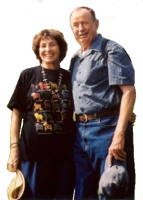
|
The Society of Folk Dance Historians (SFDH) Donna and Doug Tripp
[
Home |
About |
Encyclopedia | CLICK AN IMAGE TO ENLARGE |

|
BACKGROUND
Information: Donna and Doug Tripp, teachers of Scandinavian and international dance.
When Donna Louise Cooper was three, her mother, Emily, took her to the doctor because her feet turned under. The doctor made two recommendations: corrective shoes and dance lessons. Today, Donna still recalls wearing -- and resenting -- the shoes for many years. But the other prescription? Donna took to the lessons with enthusiasm. Not folk dance lessons, however. Emily Cooper had enrolled her three-year-old in ballet.
Emily chose Helen Noble as Donna's teacher with the biggest studio in Minneapolis (she'd put a number of stars on Broadway back in the 1920s). When Donna was eight or nine, Emily moved Donna to another teacher, Janet Atkins, at MacPhail School of Music, the largest music school in the Midwest (Janet had been a dancer with the Sadler Wells Ballet Company).
Donna grew up in the Scandinavian community in Minneapolis, Minnesota. She says, "Everyone was a Hanson or a Stensrud or an Ivarsson." Her father was half English and half Danish; the other side was Norwegian, English, French, and German.
By age eleven, already five-feet-seven-inches tall, Donna was performing. Two years later, she auditioned for the Ballet Russe de Monte Carlo, but the ballet master said she was too tall.
By her sixteenth birthday, Donna had discovered a knack for teaching, and taught adults the samba, rumba, and Lindy, while performing in ballet and Spanish dancing.
She sang in the Grace Presbyterian Church choir, studied voice and piano, and even campained for Democrat Orville Freeman (later President Kennedy's agriculture secretary). She enrolled at the University of Minnesota, planning to major in political science. Studies were soon interruted when her mother became ill.
As soon as school was out, Donna headed for Glacier National Park, where she worked one year as a maid, the next as a waitress, and the third as head waitress. That second year, the manager, recognizing Donna's "colortura" voice, asked if she would consider singing off ond on with the string trio in the dining room.
Donna skipped her senior year, moving to Los Angeles. There Doug Tripp saw her and four weeks later asked her to marry him. Donna had to go back to school in Minnesota, having a contract with a studio. Doug went to Minneapolis over Christmas and when Donna graduated the pair got married.
Donna danced ballet professionally. She also had 299 pupils in her classes at MacPhail.
Donna began going to workshops in Los Angeles and collecting dance notes. She received a scholarship to the Stockton Folk Dance Camp. In 1961, Donna began teaching international dance at Long Beach Jewish Community Center, which she continued until 1985.
In 1963, the couple joined the Gandy Dancers. They stayed with the Gandys until the mid-1970s. In 1970, Donna joined the Hungarian performing group, Betyárok, meeting with Elsie Dunin at UCLA's dance studio. The same year, the couple were introduced to Scandinavian dance during the San Diego State University Folk Dance Conference and they began attending a Scandinavian class in Santa Monica.
Donna found a job as a teller, vault teller, and then in business analysis with the Bank of America, where she stayed 27 years, retiring in July of 1994.
Doug accompanied Donna to Scandinavian dance weekends at valley of the Moon in Northern California in 1976 and other locations in 1977, 1978, and 1979.
When Nancy Linscott, who'd put on the Valley of the Moon weekend, proposed a longer, full-week camp at Mendocino in 1980, Donna said "Yes!" The camp was very successfull and Donna returned most years.
In 1984, they were asked to put on a Scandinavian performance during the Laguna Festival's Saturday night Valentine's Party. With nine couples, they cooreographed a suite which was well received. Wanting to continue, they formed the Scandia Dancers which was invited to perform for the Folk Music Week in Al, Hallingdal, Norway from May 27 through June l, 2002, along with Mikkel Thompson's Leikarring group from the San Francisco Bay area. During the six-day event, Scandia performed along with 325 other dancers from Moldavia, Estonia, and Finland (the Finns wanted to know why Donna's group performed Finnish dance). In actuality, Scandia had one Finnish suite, one Karelian suite, and two mixed suites of Swedish, Norwegian, and Danish. Scandia is a group of older, accomplished dancers and performers (originally 18 couples). Donna says that her co-director, Stefanie Holzman, should get most of the credit because she wrote the grant requests (sending six-years worth of performance videos of Donna's arrangements and choreographies) and rehearsed the group.
Years of ballet and folk dance have taken their toll on Donna's hip joints. She had her right hip replaced in 1993. In February of 2001, she had her left hip replaced but she was dancing and teaching again by the fall.
Although busy with dance, Donna does not shirk her community duties. She and her husband, Doug, are members of the Rotary Club of Brea, California. They have two children, Philip and Louise.
Dances Donna has taught include
Barjače,
De-a Lungul,
Hora pe Gheaţa I,
Hora pe Gheaţa II,
Paiduşca,
Potrkan Ples,
Reinlendar,
Somogyi Karikázó,
Srečna Ljubov,
Szatmári Körcsárdás,
and
Szegény Csárdás.
This page © 2018 by Ron Houston.
Please do not copy any part of this page without including this copyright notice.
Please do not copy small portions out of context.
Please do not copy large portions without permission from Ron Houston.